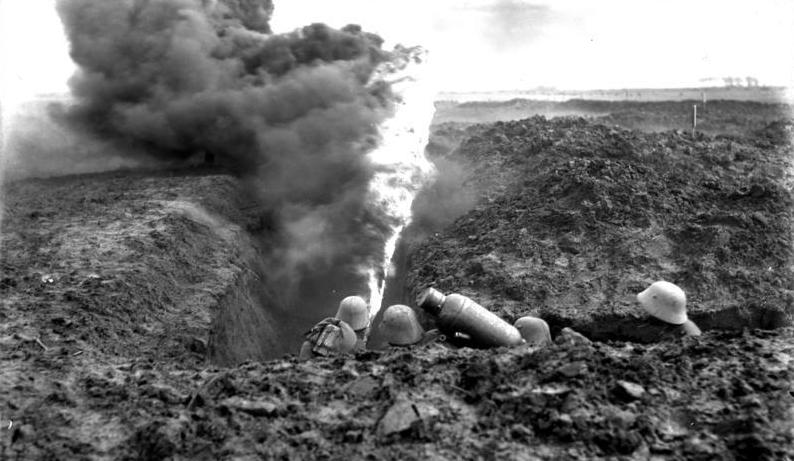Kleinflammenwerfer on:
[Wikipedia]
[Google]
[Amazon]
 The first German man-portable flamethrower was called the ''Kleinflammenwerfer'' ('small flamethrower') or ''Kleif''. Fuel was stored in a large vertical, cylindrical backpack container. High-pressure propellant was stored in another, smaller container attached to the fuel tank. A long hose connected the fuel tank to a lance tube with an igniting device at the nozzle. The propellant forced the fuel through the hose and out of the nozzle at high speed when a valve was opened. The igniting device at the nozzle set fire to the fuel as it sprayed out. The flamethrower was operated by two soldiers, one carrying the fuel and propellant tanks, another wielding the lance (though it was 31.8 kg it could be operated by one soldier). '' Wex'', a replacement for the ''Kleif'', was introduced in 1917 after the third battle of Ypres.
The ''Kleinflammenwerfer'' was created by and developed by Richard Fiedler, alongside the ''
The first German man-portable flamethrower was called the ''Kleinflammenwerfer'' ('small flamethrower') or ''Kleif''. Fuel was stored in a large vertical, cylindrical backpack container. High-pressure propellant was stored in another, smaller container attached to the fuel tank. A long hose connected the fuel tank to a lance tube with an igniting device at the nozzle. The propellant forced the fuel through the hose and out of the nozzle at high speed when a valve was opened. The igniting device at the nozzle set fire to the fuel as it sprayed out. The flamethrower was operated by two soldiers, one carrying the fuel and propellant tanks, another wielding the lance (though it was 31.8 kg it could be operated by one soldier). '' Wex'', a replacement for the ''Kleif'', was introduced in 1917 after the third battle of Ypres.
The ''Kleinflammenwerfer'' was created by and developed by Richard Fiedler, alongside the ''
History of German Flamethrower Development
1910s establishments in Germany 1910s disestablishments in Germany Flamethrowers World War I German infantry weapons {{weapon-stub
 The first German man-portable flamethrower was called the ''Kleinflammenwerfer'' ('small flamethrower') or ''Kleif''. Fuel was stored in a large vertical, cylindrical backpack container. High-pressure propellant was stored in another, smaller container attached to the fuel tank. A long hose connected the fuel tank to a lance tube with an igniting device at the nozzle. The propellant forced the fuel through the hose and out of the nozzle at high speed when a valve was opened. The igniting device at the nozzle set fire to the fuel as it sprayed out. The flamethrower was operated by two soldiers, one carrying the fuel and propellant tanks, another wielding the lance (though it was 31.8 kg it could be operated by one soldier). '' Wex'', a replacement for the ''Kleif'', was introduced in 1917 after the third battle of Ypres.
The ''Kleinflammenwerfer'' was created by and developed by Richard Fiedler, alongside the ''
The first German man-portable flamethrower was called the ''Kleinflammenwerfer'' ('small flamethrower') or ''Kleif''. Fuel was stored in a large vertical, cylindrical backpack container. High-pressure propellant was stored in another, smaller container attached to the fuel tank. A long hose connected the fuel tank to a lance tube with an igniting device at the nozzle. The propellant forced the fuel through the hose and out of the nozzle at high speed when a valve was opened. The igniting device at the nozzle set fire to the fuel as it sprayed out. The flamethrower was operated by two soldiers, one carrying the fuel and propellant tanks, another wielding the lance (though it was 31.8 kg it could be operated by one soldier). '' Wex'', a replacement for the ''Kleif'', was introduced in 1917 after the third battle of Ypres.
The ''Kleinflammenwerfer'' was created by and developed by Richard Fiedler, alongside the ''Grossflammenwerfer
The ''Grossflammenwerfer'' or ''Grof'' is a large flamethrower, designed to be used from the trenches. In addition to man-portable units, the Germans designed heavy flamethrowers before and during the First World War. The fuel and propellant conta ...
'', which was a larger flamethrower.
See also
*List of flamethrowers
This page is a list of flamethrowers of all forms from all around the world.Small arms illustrated, 2010
Human portable
Vehicle mounted
Static
See also
* List of pistols
* List of revolvers
* List of assault rifles
* List of sniper rifle ...
References
*External links
History of German Flamethrower Development
1910s establishments in Germany 1910s disestablishments in Germany Flamethrowers World War I German infantry weapons {{weapon-stub